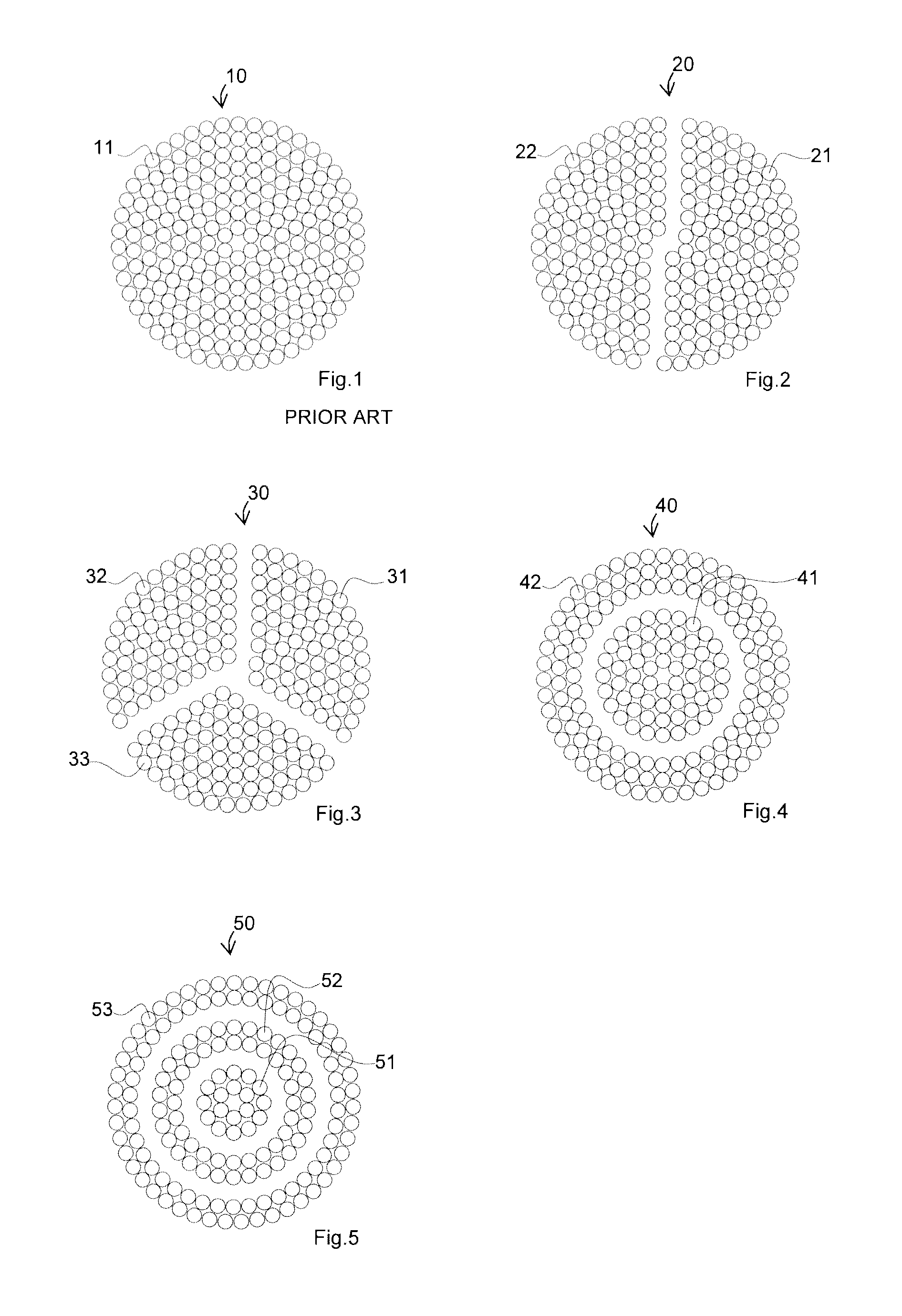Multifilaments with time-dependent characteristics, and medical products made from such multifilaments
a multi-filament, time-dependent technology, applied in the field of resorbable polymeric multi-filaments, can solve the problems of difficult and delicate tasks, severe constraints on the use of knitting or weaving patterns in practice, etc., and achieve the effects of short degradation time, long degradation time, and high modulus of elasticity
- Summary
- Abstract
- Description
- Claims
- Application Information
AI Technical Summary
Benefits of technology
Problems solved by technology
Method used
Image
Examples
first embodiment
[0019]In FIG. 2, a multifilament 20 according to the present invention is schematically illustrated in cross-section. The multifilament 20 comprises a first type of individual filaments 21 and second type of individual filaments 22. In this particular embodiment, the multifilament 20 has a generally circular composite cross-section, whereof the individual filaments 21 of the first type contribute to about fifty percent (50%) of the total composite cross-sectional area and whereof the individual filaments 22 of the second type contribute to the remaining fifty percent (50%) of the total composite cross-sectional area. More specifically, the filaments 21 of the first type occupy about a full semi-circle (at the right-hand side in FIG. 2) of the total composite cross-section, and the filaments 22 of the second type occupy the complementary full semi-circle (at the left-hand side in FIG. 2) of the total composite cross-section.
[0020]Here it should be mentioned that FIG. 2 illustrates a ...
second embodiment
[0023]In FIG. 3, a multifilament 30 according to the present invention is schematically illustrated in cross-section. The multifilament 30 comprises a first type of individual filaments 31, a second type of individual filaments 32, and a third type of individual filaments 33. In this particular embodiment, the multifilament 30 has a generally circular total composite cross-section, wherein the individual filaments 31 of the first type contribute to about a first third (33%) of the total cross-sectional area, and wherein the individual filaments 32 of the second type contribute to about a second third (33%) of the total cross-sectional area, and wherein the individual filaments 33 of the third type contribute to the remaining third (33%) of the total cross-sectional area. More specifically, the filaments 31 of the first type assume the shape of a circle sector (upper right-hand side in FIG. 3) that occupies about a third of the total circular cross-section area, while the filaments 3...
third embodiment
[0027]In FIG. 4, a multifilament 40 according to the present invention is schematically illustrated in cross-section. The multifilament 40 comprises a first type of individual filaments 41 and second type of individual filaments 42. In this particular embodiment, the multifilament 40 has a generally circular composite cross-section, wherein the individual filaments 41 of the first type constitute the core of the composite cross-section and wherein the individual filaments 42 of the second type are arranged in a concentrical arrangement with the individual filaments 42 of the second type disposed in a circular shell around the core of individual filaments 41 of the first type. For illustrative purposes only, in FIG. 4 there is an empty gap between the core and the circular shell; in reality this gap can be infinitely small, e.g. non-existing.
[0028]Here it should be mentioned that FIG. 4 illustrates a multifilament having a rather ideal circular cross-sectional shape. In reality, a tw...
PUM
| Property | Measurement | Unit |
|---|---|---|
| resorbable | aaaaa | aaaaa |
| degradation time | aaaaa | aaaaa |
| length | aaaaa | aaaaa |
Abstract
Description
Claims
Application Information
 Login to View More
Login to View More - R&D
- Intellectual Property
- Life Sciences
- Materials
- Tech Scout
- Unparalleled Data Quality
- Higher Quality Content
- 60% Fewer Hallucinations
Browse by: Latest US Patents, China's latest patents, Technical Efficacy Thesaurus, Application Domain, Technology Topic, Popular Technical Reports.
© 2025 PatSnap. All rights reserved.Legal|Privacy policy|Modern Slavery Act Transparency Statement|Sitemap|About US| Contact US: help@patsnap.com


